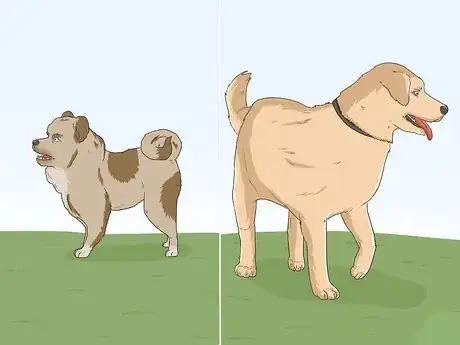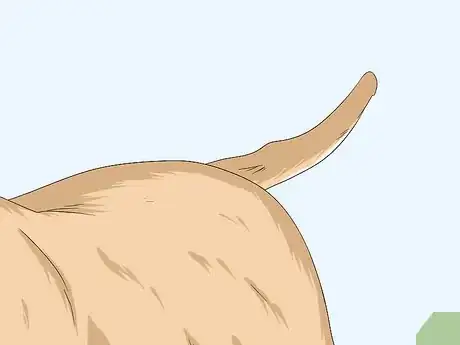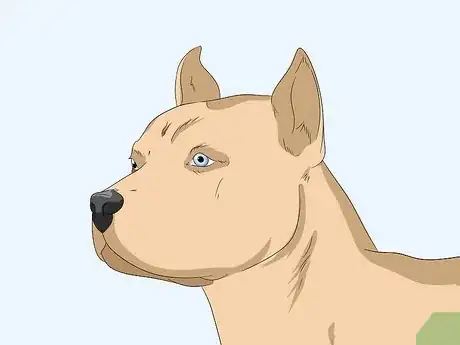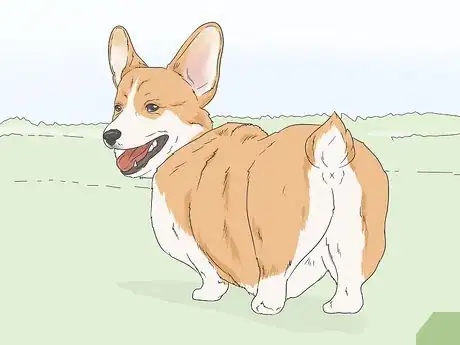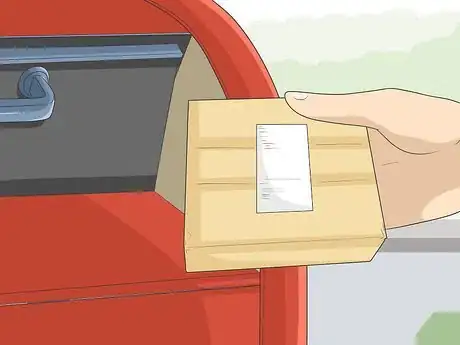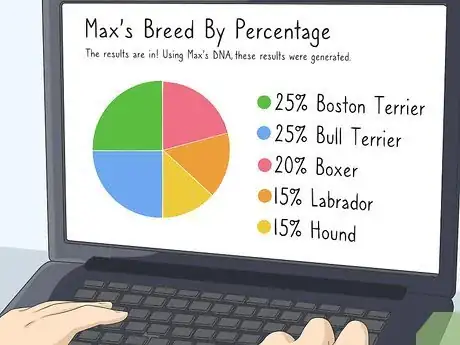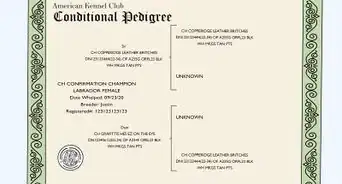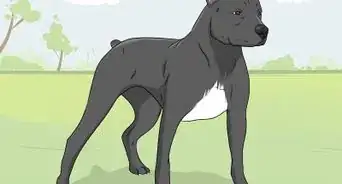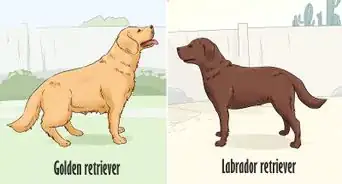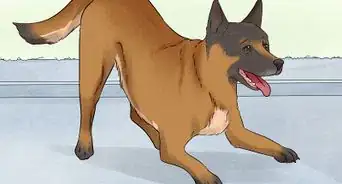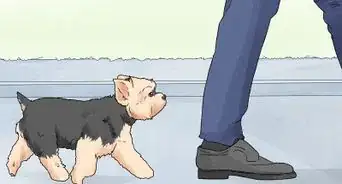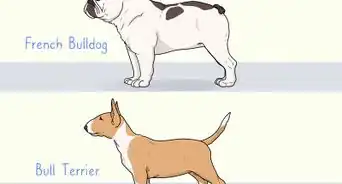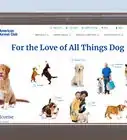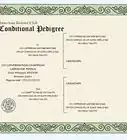This article was co-authored by Pippa Elliott, MRCVS. Dr. Elliott, BVMS, MRCVS is a veterinarian with over 30 years of experience in veterinary surgery and companion animal practice. She graduated from the University of Glasgow in 1987 with a degree in veterinary medicine and surgery. She has worked at the same animal clinic in her hometown for over 20 years.
There are 13 references cited in this article, which can be found at the bottom of the page.
This article has been viewed 346,441 times.
One of the greatest things about owning a mutt is the diversity of characteristics they may exhibit, and this diversity can also decrease their risk of certain health, temperament, and intelligence issues that often afflict purebred dogs. If your dog's background is a mystery, you may be curious about which breeds produced your beloved pup. This information can simply be fun to know, but it can also serve an important purpose, as you will know if his breed predisposes him to any genetic diseases or behavioral problems. You can use your dog's physical characteristics to help you identify his background, or you can turn to a genetic testing company to find out more.
Steps
Looking at Your Dog's Characteristics
-
1Check your dog's size. Your dog's size is related to your dog's breeds. You can't have a large mutt without him having a large-breed dog as a part of his genetic makeup.[1]
- For instance, if your dog is very small, in the 5 to 10 pounds (2.3 to 4.5 kg) range, he likely has some influence from the toy breeds, such as Toy Poodles, Chihuahuas, Papillons, and Shih Tzu.[2]
- If your dog is mid-range, in the 10 to 50 pounds (4.5 to 22.7 kg) range, he likely has some influence from a mid-range size dog, such as a terrier or spaniel.[3]
- Large dogs, in the 65 to 100 pounds (29 to 45 kg) range, include dogs such as setters, retrievers, and shepherds.[4]
- The biggest dogs, the ones that come close to 200 pounds (91 kg), likely have some giant dog in their mix, such as Saint Bernard, Komondor, or Mastiff.[5]
- Nonetheless, mutts can come in any size, and if your dog is mid-range, it may be harder to determine what breeds contributed to his genetic makeup based on size.[6]
-
2Look at your dog's ears. Different breeds have different types of ears. Your mutt's ears can be an indicator of what breeds contributed to his looks.[7]
- Bat ears are large ears that stand upright on a dog's head. They are large in proportion to the head. They may be slightly rounded. Chihuahuas and Cardigan West Corgis have these ears.[8]
- Prick ears stand upright and are pointed. You'll see these ears on malamutes and Siberian Huskies, as well as some terriers. Sometimes, prick ears are made by cutting part of the ear, and those ears are called cropped. Great Danes and Doberman Pinschers often have their ears cropped. Another variation on prick ears is hooded ears, which curve slightly in at the bottom, like on Basenji dogs.[9]
- Round-tip or blunt-tip ears are upright ears that are rounded on the ends, seen on Chow Chows or French Bulldogs.[10]
- Candle flame ears are pointed ears, but they pinch in slightly at the bottom, making them look like a candle flame. English Toy Terriers have these ears.[11]
- Button ears stand up, but the top part flops down, covering the ear canal. They're seen in Fox Terriers and Jack Russell Terriers, for example.[12]
- Cocked, semi-cropped, or semi-pricked ear stands upright, but folds just slightly over at the top, as seen in Rough Collies and Pit Bulls.[13]
- Drop ears or pendant ears drop down beside the side of the face, such as in the basset hound.[14] Another type of ear that is usually a drop style is a v-shaped ear, which is a elongated ear in a triangle shape, seen in Bull Mastiffs.[15] A folded ear is much like a drop ear. However, the ear hangs down in ruffles rather than straight down. You'll see these ears in dogs like Field Spaniels.[16]
- Filbert-shaped ears hang down, but they have an unusual shape, looking like filberts. You'll find these ears in breeds like Bedlington Terriers.[17]
- Rose ears are a type of drop ears, but they fold back instead of forward. You see these ears on Greyhounds.[18]
Advertisement -
3Check your dog's tail. Your dog's tail can also be an indicator of its breed. Dog tails come in several varieties.
- Curly tails make a little corkscrew. You see this type of tail in Pugs, Akitas, and Chow Chows, for instance.
- Bobtails are short tails that look cut-off. You see this tail on dogs such as Australian Shepherds and Pembroke Welsh Corgis.[19]
- Flagpole tails are long and straight and stand up like, well, a flagpole. You'll see these tails on dogs like Beagles.[20]
- Rat tails hang down, and they have very little hair. These tails are prominent on Irish Water Spaniels and Afghan Hounds.[21]
- You might also see saber tails and sickle tails. Saber tails hang down but curve slightly upward and are covered in fur; German Shepherds have these tails. Sickle tails curve upward over the body and are covered in fur; Siberian Huskies and Chihuahuas have these tails.[22]
-
4Look at your dog's head. The shape of your dog's head can also indicate the breed type of your dog. Head shape varies from apple-headed to blocky-headed.[23]
- Apple heads are very rounded. In fact, they look like domes. These heads are often seen on Chihuahuas.[24]
- A square-shaped head is known as a blocky head, seen in Boston Terriers.[25]
- Dogs with noses sunk into their heads and an undershot jaw are called broken-up faces, as seen in Pekingese.[26]
- Snippy-faced dogs have sharp muzzles that aren't very wide, such as Salukis.[27]
- Dogs that have faces that are concave are called dish-faced, as seen in pointers.[28]
- Dogs with down face have convex faces. Their faces are curved outward from the nose to the top of their head, as with Bull Terriers.[29]
-
5Realize you won't be able to identify your dog 100 percent. While you may be able to pull out some of the breeds of your dog just by looking at him, it is difficult to decipher ancestry in mixed-breed dogs. When dogs are mixed, they can produce interesting characteristics that you wouldn't necessarily associate with the original breed.[30]
Trying Genetic Testing
-
1Order a genetic test online. Find a reputable company that sells genetic dog tests. They will send you a kit to help you test your DNA.[31] Two of the major companies are Wisdom Panel and DNA My Dog.[32]
- While these tests can provide some information, they aren't foolproof. In fact, getting tests from two different companies may show a different mixture of breeds.[33]
- See if you can find out which company has the widest database of dog breeds on file and choose the company with the most breeds. They will have a wider reference range and will be better able to more accurately identify your dog.
- It's especially difficult to identify breeds if your dog has a larger number than other dogs; if your dog just has a couple of breeds, it may be easier to identify.[34]
-
2Take a swab of your dog's cheek. The kit will come with two cotton swabs. All you do is rub it on the inside of your dog's cheek. Let them dry out, and stick them back in the envelope.[35]
-
3Activate your kit. Some websites, such as Wisdom Panel, require that you activate your kit online at this point. You'll be given a code to write on your sample sticker.[36]
-
4Mail it back in. Many kits come with the shipping label included. All you have to do is stick the kit back in the mail.[37]
-
5Wait for the results. The company will mail back the genetic makeup of your dog. Some panels claim to go back as far as great-grandparents in identifying the breeds that makeup your dog.[38]
Expert Q&A
Did you know you can get expert answers for this article?
Unlock expert answers by supporting wikiHow
-
QuestionWhat is the Doge dog?
 Pippa Elliott, MRCVSDr. Elliott, BVMS, MRCVS is a veterinarian with over 30 years of experience in veterinary surgery and companion animal practice. She graduated from the University of Glasgow in 1987 with a degree in veterinary medicine and surgery. She has worked at the same animal clinic in her hometown for over 20 years.
Pippa Elliott, MRCVSDr. Elliott, BVMS, MRCVS is a veterinarian with over 30 years of experience in veterinary surgery and companion animal practice. She graduated from the University of Glasgow in 1987 with a degree in veterinary medicine and surgery. She has worked at the same animal clinic in her hometown for over 20 years.
Veterinarian
-
QuestionIs there a test to see what breed your dog is?
 Pippa Elliott, MRCVSDr. Elliott, BVMS, MRCVS is a veterinarian with over 30 years of experience in veterinary surgery and companion animal practice. She graduated from the University of Glasgow in 1987 with a degree in veterinary medicine and surgery. She has worked at the same animal clinic in her hometown for over 20 years.
Pippa Elliott, MRCVSDr. Elliott, BVMS, MRCVS is a veterinarian with over 30 years of experience in veterinary surgery and companion animal practice. She graduated from the University of Glasgow in 1987 with a degree in veterinary medicine and surgery. She has worked at the same animal clinic in her hometown for over 20 years.
Veterinarian
-
QuestionHow much does a dog DNA test cost at a vet?
 Pippa Elliott, MRCVSDr. Elliott, BVMS, MRCVS is a veterinarian with over 30 years of experience in veterinary surgery and companion animal practice. She graduated from the University of Glasgow in 1987 with a degree in veterinary medicine and surgery. She has worked at the same animal clinic in her hometown for over 20 years.
Pippa Elliott, MRCVSDr. Elliott, BVMS, MRCVS is a veterinarian with over 30 years of experience in veterinary surgery and companion animal practice. She graduated from the University of Glasgow in 1987 with a degree in veterinary medicine and surgery. She has worked at the same animal clinic in her hometown for over 20 years.
Veterinarian
References
- ↑ http://www.merckvetmanual.com/pethealth/dog_basics/description_and_physical_characteristics_of_dogs/description_and_physical_characteristics_of_dogs.html
- ↑ http://www.merckvetmanual.com/pethealth/dog_basics/description_and_physical_characteristics_of_dogs/description_and_physical_characteristics_of_dogs.html
- ↑ http://www.merckvetmanual.com/pethealth/dog_basics/description_and_physical_characteristics_of_dogs/description_and_physical_characteristics_of_dogs.html
- ↑ http://www.merckvetmanual.com/pethealth/dog_basics/description_and_physical_characteristics_of_dogs/description_and_physical_characteristics_of_dogs.html
- ↑ http://www.merckvetmanual.com/pethealth/dog_basics/description_and_physical_characteristics_of_dogs/description_and_physical_characteristics_of_dogs.html
- ↑ http://www.merckvetmanual.com/pethealth/dog_basics/description_and_physical_characteristics_of_dogs/description_and_physical_characteristics_of_dogs.html
- ↑ http://www.caninest.com/dog-ear-types/
- ↑ http://www.caninest.com/dog-ear-types/
- ↑ https://www.psychologytoday.com/blog/canine-corner/201208/what-shape-is-your-dogs-ear
- ↑ http://www.caninest.com/dog-ear-types/
- ↑ https://www.psychologytoday.com/blog/canine-corner/201208/what-shape-is-your-dogs-ear
- ↑ http://www.caninest.com/dog-ear-types/
- ↑ http://www.caninest.com/dog-ear-types/
- ↑ https://www.psychologytoday.com/blog/canine-corner/201208/what-shape-is-your-dogs-ear
- ↑ http://www.caninest.com/dog-ear-types/
- ↑ https://www.psychologytoday.com/blog/canine-corner/201208/what-shape-is-your-dogs-ear
- ↑ http://www.caninest.com/dog-ear-types/
- ↑ https://www.psychologytoday.com/blog/canine-corner/201208/what-shape-is-your-dogs-ear
- ↑ http://www.caninest.com/dog-tail-types/
- ↑ http://www.caninest.com/dog-tail-types/
- ↑ http://www.caninest.com/dog-tail-types/
- ↑ http://www.caninest.com/dog-tail-types/
- ↑ https://www.dog.com/content/dog-health/your-dogs-head/
- ↑ https://www.dog.com/content/dog-health/your-dogs-head/
- ↑ https://www.dog.com/content/dog-health/your-dogs-head/
- ↑ https://www.dog.com/content/dog-health/your-dogs-head/
- ↑ https://www.dog.com/content/dog-health/your-dogs-head/
- ↑ https://www.dog.com/content/dog-health/your-dogs-head/
- ↑ https://www.dog.com/content/dog-health/your-dogs-head/
- ↑ http://stopbsl.org/bsloverview/impossibleid/
- ↑ https://vetdnacenter.com/dna-tests/canine-dna-testing/canine-dna-breed-testing/
- ↑ https://fortune.com/2015/06/25/dog-dna-tests/
- ↑ https://fortune.com/2015/06/25/dog-dna-tests/
- ↑ http://pets.webmd.com/dogs/features/dog-dna-testing
- ↑ http://www.wisdompanel.com/how_it_works/
- ↑ http://www.wisdompanel.com/how_it_works/
- ↑ https://vetdnacenter.com/dna-tests/canine-dna-testing/canine-dna-breed-testing/
- ↑ https://vetdnacenter.com/dna-tests/canine-dna-testing/canine-dna-breed-testing/
About This Article
To identify your adopted mutt, consider its size and weight, since very small dogs likely have some influence from toy breeds, like Chihuahuas or Shih Tzus. Alternatively, large dogs may have breeds such as retrievers and shepherds in their background. Additionally, examine its tail, which may be a variety such as bobtail, often seen in breeds like Australian Shepherd or Pembroke Welsh Corgi. You should also look at the shape of your dog’s head, which may be a round dome, such as that of a Chihuahua, or square shaped, like a Boston Terrier. For more tips from our Veterinary co-author, like how to figure out your dog’s breed based on its ears, read on!
